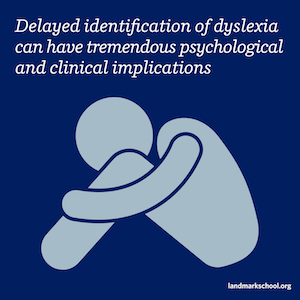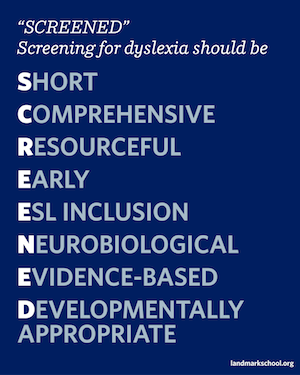- Our School
- Our Advantage
- Admission
- Elementary•Middle School
- High School
- Summer
- Giving
- Parent Resources
- For Educators
- Alumni
« Back
MYTH 1
MYTH 2
MYTH 3
It’s a Myth That Young Children Cannot Be Screened for Dyslexia
November 8th, 2017
This is part four of the five-part series, What Is a Language-Based Learning Disability?
Originally published on the International Dyslexia Association website, Feb. 2017
A diagnosis of developmental dyslexia in elementary school is primarily based upon a “wait-to-fail-approach.” This approach requires a child to demonstrate a significant struggle to learn to read over a prolonged period of time before more intensive (quality and quantity) interventional strategies are discussed and eventually put into place. Paradoxically, although a diagnosis of dyslexia usually is not given before the end of second grade or the beginning of third grade (after the requisite period of failing), intensive interventions are most effective in kindergarten or first grade (Wanzek & Vaughn, 2007). 
Not only has this added to the difficulty of remediation, this practice of delayed identification of dyslexia can have tremendous psychological and clinical implications. Children with dyslexia show an increased incidence of internalizing anxious and depressive symptomatology (Mugnaini, Lassi, La Malfa, & Albertini, 2007) and are less likely to complete high school (Jimerson, Egeland, Sroufe, & Carlson, 2000) or to enroll in programs of higher education (Dougherty, 2003).
So, why are we not identifying children at risk earlier and providing them with the resources and tools they need to learn to read as early as possible? Here, I will review three common myths associated with early screening for children at risk for dyslexia.
MYTH 1
Signs of dyslexia can be seen only after two to three years of reading instruction.
While a diagnosis of dyslexia currently requires repeated failure in learning to read, this does not mean that early signs of dyslexia cannot be observed in preschool (or possibly earlier). Deficits in phonological awareness, rapid automatized naming, verbal working memory, and letter knowledge have been shown to be robust precursors of dyslexia in children as young as age 3 (Puolakanaho et al., 2007).
A recent study of more than 1,200 kindergartners in New England not only identified six independent reading profiles, including three dyslexia risk profiles, but also showed that these reading profiles are remarkably stable over a two-year window (Ozernov-Palchik, in press).
Furthermore, studies involving brain measures, such as electroencephalography or magnetic resonance imaging, have shown that the brain characteristics of individuals with dyslexia can be observed as early as infancy and preschool, especially in children with a genetic risk for dyslexia.
A longitudinal dyslexia study in Finland, which followed children from birth until age 8, showed that early differential brain measures could distinguish at-risk children who later developed reading problems from those who did not (Leppanen et al., 2010). Additionally, several studies have shown alterations in white matter (the highways that connect two brain areas and enable fast information flow) in young pre-reading children who subsequently developed a reading disability (Wang et al., in press; Kraft et al., 2016). These studies suggest that these children are stepping into their first day of kindergarten with a brain less optimized to learn to read. Why wait three or more years before we give them access to additional resources essential for improving their reading performance?
MYTH 2
Even with early screening, early intervention is not effective.
It is certainly true that most reading interventions are designed for older children who have been struggling for some time. However, converging evidence points to the importance of high-quality classroom reading instruction in early grades and early interventions for at-risk students (e.g., in a small-group setting) to improve the effectiveness of remediation (Blachman et al., 2004).
A meta-analysis comparing intervention studies of at least 100 sessions reported larger effect sizes in kindergarten and first grade than in the later grades. Furthermore, a meta-analysis across six studies revealed that when at-risk beginning readers received explicit and intensive instruction, 50% to 90% of these children reached average reading performance levels (Torgesen, 2004). Without high-quality instruction and intervention, early reading problems can manifest as serious reading disabilities later on (Stanovich, 1986). Moreover, several studies have shown that the brain’s ability to change and adapt in response to experience (brain plasticity) decreases throughout the childhood years (Johnson, 2001; Johnston, 2009) and that certain skills are harder to acquire after a ‘sensitive period’ (Johnson, 2005). For instance, for most people, learning to speak a second language, especially without an accent, comes with relative ease in early childhood but becomes more difficult later in life (Birdsong, 2001).
MYTH 3
Early screening costs too much for school districts, and there is no time for additional testing.
There is some truth to this statement. Each school and district must determine the costs of early universal screening. However, many districts already have valid tools for screening the key indicators of dyslexia on hand—the same tools used in second or third grade to assess children who repeatedly fail to learn to read. Reading specialists or special education teachers already may be trained to administer these assessments.
Early assessment could be conducted prior to the start of kindergarten (e.g., in combination with some pre-kindergarten events that already occur), at daycare centers, preschools, or even in collaboration with pediatricians’ offices at the 4- or 5-year-old well-visits. This may add some personal costs, but would reduce screening hours and associated costs later in the school year and beyond.
Additional resources are needed for the interpretation and dissemination of the screenings and their results. Various companies now offer the scoring of standardized tests with turnarounds as fast as two weeks, and several online screening tools currently under development aim to reduce both labor and early screening costs.
Yes, early screenings entail significant costs, but given the costs associated with remediation and the treatment of accompanying psychological and medical problems (e.g., depression, anxiety, and psychosomatic conditions related to academic stress), the benefits of early screening outweigh the costs.
It is important to note that the re-allocation of resources for early identification/intervention should not negatively impact intervention efforts in older grades. More specifically, there will be students in older grades who need intervention, and funds used for early intervention should not be taken from the funds currently allocated for older students. If early screening and early intervention achieve expected goals, eventually there should be fewer older students who need that intense intervention. In the interim, those who missed the early screening and intervention still exist. Also, once early screening and early intervention become routine and effective (even with a 50% to 90% success rate), there will be some older students who continue to need support.
What Should Early Screening Look Like?
 I recommend incorporating eight key characteristics when determining an optimal screening battery for an individual classroom, school, or district. The first letters of these characteristics spell the acronym SCREENED.
I recommend incorporating eight key characteristics when determining an optimal screening battery for an individual classroom, school, or district. The first letters of these characteristics spell the acronym SCREENED.
SHORT A screening battery should be no longer than 30 minutes. The goal is to identify children at risk in key domains and not to diagnose or comprehensively evaluate specific strengths and weaknesses.
COMPREHENSIVE Although short, a screening battery should include all the key domains, including phonological awareness, letter knowledge (letter-sound knowledge for kindergarten and older), rapid automatized naming, vocabulary, listening comprehension, and family history (see below).
RESOURCEFUL Most schools/districts already own assessments that can be used to assess the key domains in young children since these are used in second or third grade to assess children who are repeatedly struggling to learn to read.
EARLY Screening should be implemented as early as preschool but no later than kindergarten.
ESL/DIALECT INCLUSION Children who are English learners or speakers of dialect need to be included. Minority children and children from low socioeconomic backgrounds have been shown to have an increased risk for developing reading problems, which can be explained by differences in the quality and quantity of preschool literacy experiences and overall language exposure (Washington, 2001). Prior to third grade, culturally and linguistically diverse children with reading difficulties are under-diagnosed. After third grade, these children are often over-diagnosed (Mancilla-Martinez & Lesaux, 2011) because they are not identified early and do not gain access to the additional resources desperately needed to improve their reading performance.
It is important to note that teacher training is an essential piece in the screening equation. Teachers need to know how to address specific deficits once a child has been identified in order to implement early evidence-based instruction for all at-risk students.
NEUROBIOLOGY/GENETICS The cheapest and fastest screening is to ask parents  whether there is a family history of reading disabilities. Dyslexia is strongly heritable, occurring in up to 50% of individuals who have a first-degree relative with dyslexia (Pennington, 1991). The risk and severity of dyslexia is higher when both parents are affected (Wolff & Melngalailis, 1994).
whether there is a family history of reading disabilities. Dyslexia is strongly heritable, occurring in up to 50% of individuals who have a first-degree relative with dyslexia (Pennington, 1991). The risk and severity of dyslexia is higher when both parents are affected (Wolff & Melngalailis, 1994).
EVIDENCE-BASED RESPONSE TO SCREENING The best early screening battery will not make a difference if classroom instruction/intervention does not target the specific deficits with evidence-based instruction/intervention. The goal is not to refer the at-risk children to special education but to address their specific deficits within the classroom environment.
DEVELOPMENTALLY APPROPRIATE The assessment components of the screening need to be developmentally appropriate for the targeted age range.
It is important to note that teacher training is an essential piece in the screening equation. Teachers need to know how to address specific deficits once a child has been identified in order to implement early evidence-based instruction for all at-risk students. Furthermore, additional teacher training, professional development, classroom resources, and increased districtwide dyslexia awareness benefit all students.
Educators and researchers must work together to ensure that all young students are SCREENED, to ensure their access to evidence-based instruction/intervention, and most importantly, to maximize their joy in learning to read.
Through Landmark School’s blog, Landmark360.org, we launched the five-part series What Is a Language-Based Learning Disability? This is the fourth article in the series. Other articles defined LBLD, addressed assessment of LBLD, discussed the importance of remediation of LBLD, and presented a case study of a family with two children with LBLDs.
References
Wanzek, J. & Vaughn, S. Research-based implications from extensive early reading interventions. School Psychology Review, 36, 541 (2007).
Mugnaini, D., Lassi, S., La Malfa, G. & Albertini, G. Internalizing correlates of dyslexia. World Journal of Pediatrics, 5, 255–264 (2009).
Jimerson, S., Egeland, B., Sroufe, L. A. & Carlson, B. A prospective longitudinal study of high school dropouts examining multiple predictors across development. Journal of school psychology, 38, 525–549 (2000).
Dougherty, C. Numeracy, literacy and earnings: evidence from the National Longitudinal Survey of Youth. Economics of education review, 22, 511–521 (2003).
Puolakanaho, A. et al. Very early phonological and language skills: estimating individual risk of reading disability. J Child Psychol Psychiatry, 48, 923–931 (2007).
Ozernov-Palchik, O. et al. Longitudinal stability of pre-reading skill profiles of kindergarten children. Developmental Science (In press).
Leppanen, P. H., Hamalainen, J. A., Salminen, H. K., Eklund, K. M., Guttorm, T. K., Lohvansuu, K., Puolakanaho, A., & Lyytinen, H. Newborn brain event-related potentials revealing atypical processing of sound frequency and the subsequent association with later literacy skills in children with familial dyslexia. Cortex, 46, 1362–1376 (2010).
Wang, Y. et al. Development of tract-specific white matter pathways during early reading development in at-risk children and typical controls. Cerebral Cortex, doi:10.1093/cercor/bhw095 (In press).
Kraft, I. et al. Predicting early signs of dyslexia at a preliterate age by combining behavioral assessment with structural MRI. Neuroimage, 143, 378–386 (2016).
Blachman, B. A. et al. Effects of intensive reading remediation for second and third graders and a 1-year follow-up. Journal of Educational Psychology, 96, 444–461 (2004).
Torgesen, J. K. Avoiding the devastating downward spiral: The evidence that early intervention prevents reading failure. American Educator, 28, 6–19 (2004).
Stanovich, K. E. Matthew effects in reading: Some consequences of individual differences in the acquisition of literacy. Reading Research Quarterly, 21, 360–407 (1986).
Johnson, M. H. Functional brain development in humans. Nature Reviews Neuroscience, 2, 475–483 (2001).
Johnston, M. V. Plasticity in the developing brain: implications for rehabilitation. Developmental Disabilities Research Reviews, 15, 94–101 (2009).
Johnson, M. H. Sensitive periods in functional brain development: problems and prospects. Developmental Psychobiology, 46, 287–292 (2005).
Birdsong, D. & Mollis, M. On the evidence for maturational constraints in second language acquisition. Journal of Memory and Language, 44, 235–249 (2001).
Washington, J. A. Early literacy skills in African-American children: Research considerations. Learning Disabilities Research & Practice, 16, 213–221 (2001).
Mancilla-Martinez, J. & Lesaux, N. K. The gap between Spanish speakers’ word reading and word knowledge: a longitudinal study. Child Development, 82, 1544–1560 (2011).
Pennington, B. F. Reading Disabilities: Genetic and Neurological Influences. (Kluwer, 1991).
Wolff, P. H. & Melngailis, I. Family patterns of developmental dyslexia: clinical findings. Am J Med Genet, 54, 122–131, doi:10.1002/ajmg.1320540207 (1994).
Author
Dr. Gaab is an Associate Professor of Pediatrics at Boston Children’s Hospital and the Harvard Medical School and a member of the faculty at the Harvard Graduate School of Education. She received a PhD in Psychology from the University of Zurich in Switzerland. She did postdoctoral training with John Gabrieli, Gary Glover, and Paula Tallal at Stanford University and MIT. Her current research within the Laboratories of Cognitive Neuroscience at Boston Children’s Hospital focuses on auditory and language processing in the human brain and its applications for the development of typical and atypical language and literacy skills.

What Is a Language-Based Learning Disability? Five Part Series
This is part four of the five-part series, What Is a Language-Based Learning Disability?
Part One: What We Know About LBLD and Learning, by Bob Broudo
Part Two: Language-Based Learning Disabilities: A Primer, by Melody O'Neil
Part Three: Help Your Struggling Learner: Remediation Is a Key to Success, by Christine Ozahowski
Part Four: It's a Myth That Young Children Cannot Be Screened for Dyslexia, by Nadine Gaab, PhD
Part Five: Language-Based Learning Disabilities on the Homefront, by Angela Timpone Gowans
![]() Landmark360.org's post by Bob Broudo about LBLD and Learning won a 2017 Gold InspirED School Marketers Brilliance Award in the national competition that recognizes excellence in private and independent school marketing and communications.
Landmark360.org's post by Bob Broudo about LBLD and Learning won a 2017 Gold InspirED School Marketers Brilliance Award in the national competition that recognizes excellence in private and independent school marketing and communications.
Posted in the category Learning Disabilities.








.jpg?v=1652115432307)












